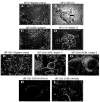Characterization of peripheral blood human immunodeficiency virus isolates from Hispanic women with cognitive impairment
- PMID: 17849315
- PMCID: PMC2925199
- DOI: 10.1080/13550280701361508
Characterization of peripheral blood human immunodeficiency virus isolates from Hispanic women with cognitive impairment
Abstract
Human immunodeficiency virus type 1 (HIV-1) tropism plays an important role in HIV-associated dementia. In this study, aimed at determining if the tropism and coreceptor usage of circulating viruses correlates with cognitive function, the authors isolated and characterized HIV from the peripheral blood of 21 Hispanic women using antiretroviral therapy. Macrophage tropism was determined by inoculation of HIV isolates onto monocyte-derived macrophages and lymphocyte cultures. To define coreceptor usage, the HIV isolates were inoculated onto the U87.CD4 glioma cell lines with specific CCR5 and CXCR4 coreceptors. HIV isolates from cognitively impaired patients showed higher levels of replication in mitogen-stimulated peripheral blood mononuclear cells than did isolates from patients with normal cognition (P < .05). The viral growth of HIV primary isolates in macrophages and lymphocytes did not differ between patients with and those without cognitive impairment. However, isolates from the cognitively impaired women preferentially used the X4 coreceptor (P < .05). These phenotypic studies suggest that cognitively impaired HIV-infected women receiving treatment may have a more highly replicating and more pathogenic X4 virus in the circulation that could contribute to their neuropathogenesis.
Figures



Similar articles
-
Proteomic analyses of monocyte-derived macrophages infected with human immunodeficiency virus type 1 primary isolates from Hispanic women with and without cognitive impairment.J Neurovirol. 2009 Jan;15(1):36-50. doi: 10.1080/13550280802385505. Epub 2008 Dec 26. J Neurovirol. 2009. PMID: 19115125 Free PMC article.
-
Inhibition of dual/mixed tropic HIV-1 isolates by CCR5-inhibitors in primary lymphocytes and macrophages.PLoS One. 2013 Jul 9;8(7):e68076. doi: 10.1371/journal.pone.0068076. Print 2013. PLoS One. 2013. PMID: 23874501 Free PMC article.
-
Macrophage tropism of human immunodeficiency virus type 1 isolates from brain and lymphoid tissues predicts neurotropism independent of coreceptor specificity.J Virol. 2001 Nov;75(21):10073-89. doi: 10.1128/JVI.75.21.10073-10089.2001. J Virol. 2001. PMID: 11581376 Free PMC article.
-
The CCR5 and CXCR4 coreceptors are both used by human immunodeficiency virus type 1 primary isolates from subtype C.J Virol. 2003 Apr;77(7):4449-56. doi: 10.1128/jvi.77.7.4449-4456.2003. J Virol. 2003. PMID: 12634405 Free PMC article.
-
The role of viral coreceptors and enhanced macrophage tropism in human immunodeficiency virus type 1 disease progression.Sex Health. 2004;1(1):23-34. doi: 10.1071/sh03006. Sex Health. 2004. PMID: 16335478 Review.
Cited by
-
Interacting partners of macrophage-secreted cathepsin B contribute to HIV-induced neuronal apoptosis.AIDS. 2015 Oct 23;29(16):2081-92. doi: 10.1097/QAD.0000000000000823. AIDS. 2015. PMID: 26208400 Free PMC article.
-
Proteomic analyses of monocyte-derived macrophages infected with human immunodeficiency virus type 1 primary isolates from Hispanic women with and without cognitive impairment.J Neurovirol. 2009 Jan;15(1):36-50. doi: 10.1080/13550280802385505. Epub 2008 Dec 26. J Neurovirol. 2009. PMID: 19115125 Free PMC article.
-
Up-regulation of the neuronal nicotinic receptor α7 by HIV glycoprotein 120: potential implications for HIV-associated neurocognitive disorder.J Biol Chem. 2012 Jan 27;287(5):3079-86. doi: 10.1074/jbc.M111.262543. Epub 2011 Nov 14. J Biol Chem. 2012. PMID: 22084248 Free PMC article.
-
Envelope gene evolution and HIV-1 neuropathogenesis.J Neuroinfect Dis. 2015 Oct;6(Suppl 2):003. doi: 10.4172/2314-7326.S2-003. Epub 2015 Aug 20. J Neuroinfect Dis. 2015. PMID: 27135036 Free PMC article.
-
HIV gp120 sequence variability associated with HAND in Hispanic Women.J Virol Antivir Res. 2015;4(3):143. doi: 10.4172/2324-8955.1000143. Epub 2015 Oct 6. J Virol Antivir Res. 2015. PMID: 27358904 Free PMC article.
References
-
- American Academy of Neurology AIDS Task Force. Nomenclature and research case definitions for neurologic manifestations of human immunodeficiency virus-type 1 (HIV-1) infection. Report of a working group of the American Academy of Neurology AIDS task force. Neurol. 1991;41:778–785. - PubMed
-
- American Academy of Neurology AIDS Task Force. Clinical confirmation of the American Academy of Neurology algorithm for HIV-1-associated cognitive/motor disorder. The Dana Consortium on Therapy for HIV Dementia and Related Cognitive Disorders. Neurol. 1996;47:1247–1253. - PubMed
-
- Arroyo MA, Tien H, Pagan M, Swanstrom R, Hillyer GV, Cadilla CL, Melendez-Guerrero LM. Virologic risk factors for vertical transmission of HIV type 1 in Puerto Rico. AIDS Res Hum Retroviruses. 2002;18:447–460. - PubMed
-
- Bajetto A, Bonavia R, Barbero S, Piccioli P, Costa A, Florio T, Schettini G. Glial and neuronal cells express functional chemokine receptor CXCR4 and its natural ligand stromal cell-derived factor 1. J Neurochem. 1999;73:2348–2357. - PubMed
-
- Bakri Y, Amzazi S, Mannioui A, Benjouad A. The susceptibility of macrophages to human immunodeficiency virus type 1 X4 isolates depends on their activation state. Biomed Pharmacother. 2001;55:32–38. - PubMed
Publication types
MeSH terms
Substances
Grants and funding
LinkOut - more resources
Full Text Sources
Research Materials

